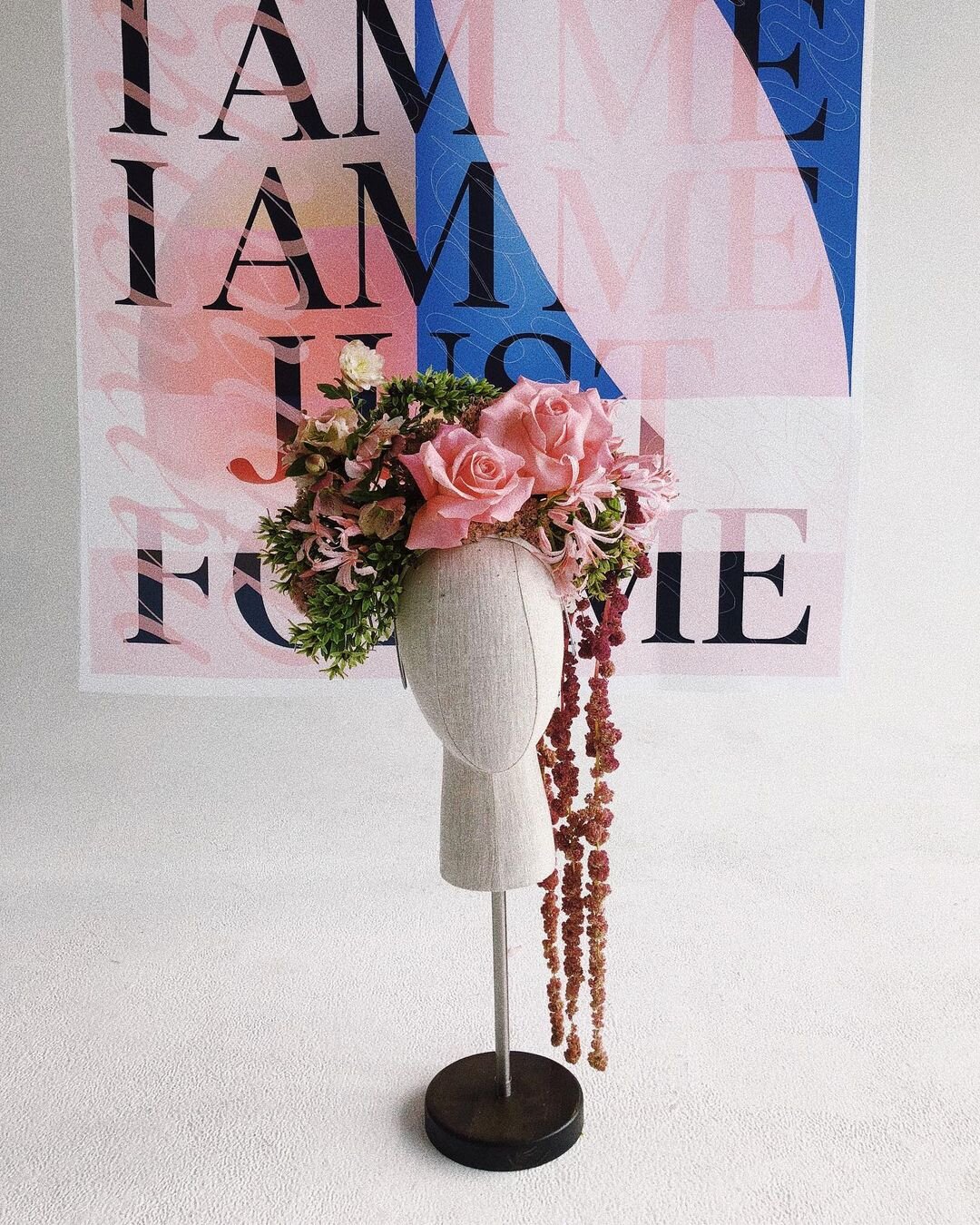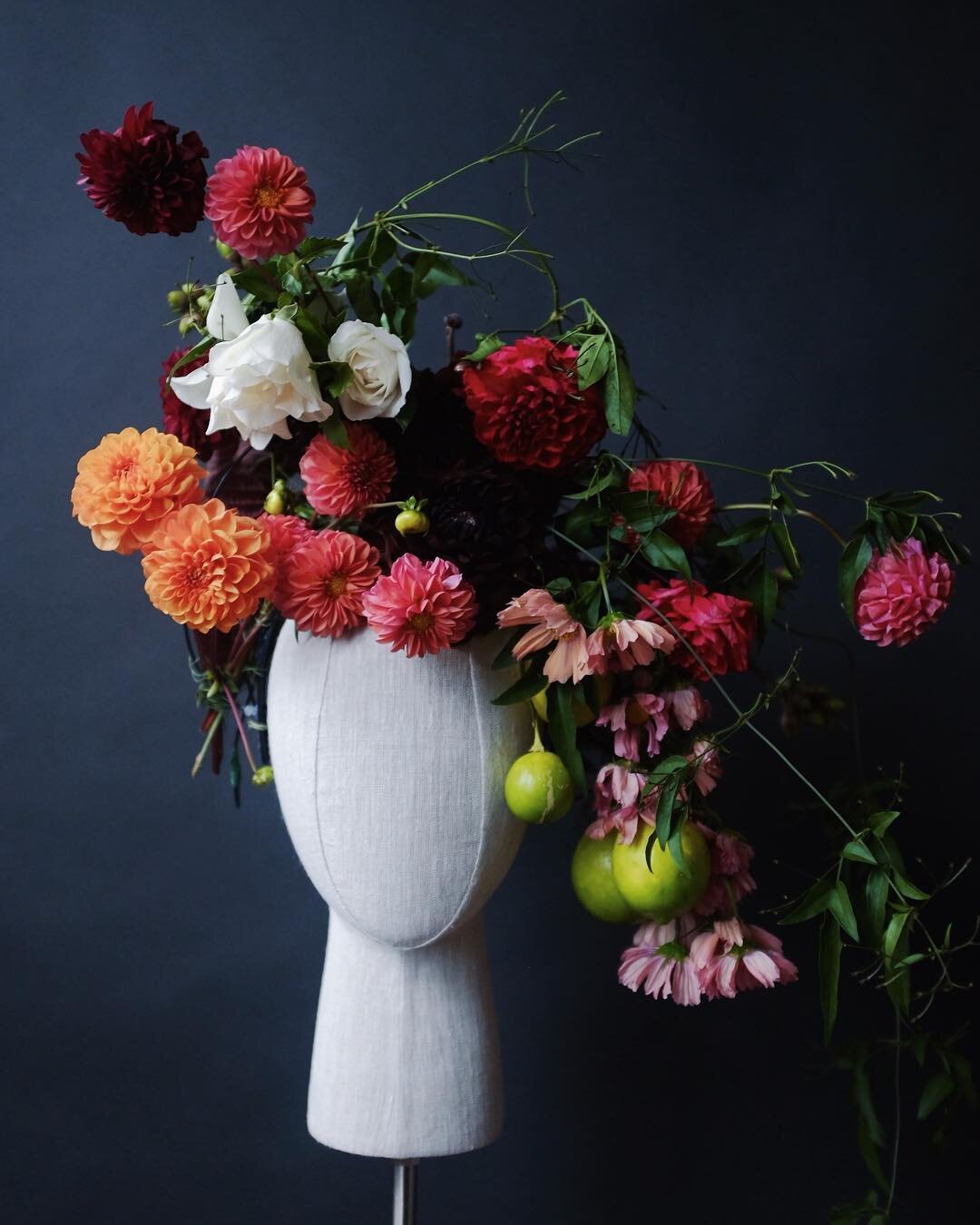The Ephemeral & Intangible Art of Wearable Florals with Jeannie Huang
Harper's Bazaar: Death to the Flower Crown
I began my work with flower crowns about five years ago out of budget necessity. At the time I wanted to set up my own floral business, but I didn't have a few thousand to invest in a mock wedding photoshoot (which is how a lot of florists begin seeding their portfolios). Flower crown shoots were smaller yet felt more substantial than simple bouquet snapshots, and also provided the chance to work with budding photographers who were looking to fill their own portfolios as well. My first shoots were all photographed and modeled by friends, and our budget was so low I even stood in as the haphazard makeup artist on occasion.
Anadem IV: Billy



When I’m making the floral headpieces for a shoot or an event, I’m first and foremost aware of the limitations of working with perishables; flowers are quick to wilt without a direct water source and with constant heat emitting from the wearer’s body and from studio or event lights. Sourcing the right hardy flowers and knowing how to prep them for wearables is a big portion of my work on set. I also spend a lot of time working through how to elevate the flowers into the right structure and shape for the image. Flowers have a surprising amount of weight and heft to them that can be quite unwieldy, and also extremely uncomfortable to wear long term, so balancing wearability with the final look is a huge part of the craft. The actual floral work is easy; the flowers do all the work of being beautiful and I use floral wire, glue, or tape to guide them. The hard part is thinking through the layers of execution to get to the final image (from styling to makeup to hair to structure) and how it'll all work together in a cohesive moment.
Chinese opera headpiece
With each shoot and collaboration I did in the early days, I also learned about what goes into crafting an image instead of just focusing on a physical structure to house the flowers. My flower headpieces are designed to invoke specific imagery for the viewer, from iconic Christian imagery of Mother Mary, resplendent and glowing in a halo of roses, to the traditional genderfluid Chinese opera headpiece, traditionally worn by male performers depicting female characters. Floral imagery spans our global consciousness across both time and culture, which sharply contrasts with the frail impermanence inherent to fresh flowers. It's inevitable to read religious, cultural, and political undertones to flowers and every image I make inherently (and sometimes accidentally) refers to those undertones.
I particularly like working with independent designers to incorporate their thought processes around the clothing into the final image itself. For example, in a shoot centered on Taiwanese identity it felt incredibly important that we source our clothing from a native-born Taiwanese designer as well. After some research, I found Taipei-based designer James Mayi who intentionally combines rich brocade and temple imagery with modern silhouettes and palettes into his pieces. His work was a perfect reflection of what I was trying to do with the floral headpiece. Another favorite shoot featured recent fashion school graduate Rui Zhou, whose gauzy knit bodysuits invoke her longing to reach across oceans to reconnect with mothers, sisters, and friends. I wanted to mirror the same intimacy in the shoot so we had two models interacting in the photos, barely touching each other while wearing similarly delicate flowers. The intentionality behind their craft not only mirrors mine, it fuels it, and I think the images we make together are stronger for it.
“As I See Me” with MITH Magazine
More recently, I've started to think about the floral photoshoots as a visual extension of my subconscious: What do I think about my work? What do I think about myself? What else am I handling, outside of the actual manual labor of working with the physical flowers? I try not to force myself to answer these questions in a concrete way, but to focus on the exploration, or the struggle of coming up with an answer at all, visually through my work. It has shown up in the photos I’ve created around the Asian-American female body, with lush, nude florals pouring out of full-bellied moon vases made by friend and co-conspirator Robyn Ng. Or in shoots about holding space between women, exploring negative space and intimate touch, crowned with opposing florals that don't quite match. I never try to explain my thoughts through the work; I am more concerned with just getting the thoughts out into the world, visually. I'm not sure that I've done a good job fully fleshing out my inner universe in any of my images, but there's a release in putting them out into the physical world.
Full-bellied moon vases by Robyn Ng
It’s hard for me to talk about my work without acknowledging how deeply flower crowns have become cemented in the visual culture of this decade. My biggest editorial photoshoot was with Harper’s Bazaar in 2018, but by that point floral headpieces had already been popularized on Pinterest by thousands of "boho brides" as part of the farmhouse wedding aesthetic. Three months later, Beyoncé released a cover on Vogue of her wearing an enormous floral headpiece and it pushed flower wearables into the spotlight for celebrities and editorial shoots alike. Since then, classes, books, and Katy Perry music videos featuring flowers-as-clothing have exploded onto the mainstream. It just shows how, the art of adorning our bodies with flowers comes from time immemorial, even as early as creation stories have featured wearing fig leaves for the body. Even if the concept is ancient, what makes this work exciting is that we are still finding new forms, silhouettes, and meaning behind the why and how we dress ourselves with flowers.
Over the past year, I started creating more floral work in augmented reality as well, sculpting increasingly impractical virtual floral pieces that would be painstaking to build in real life but that anyone could try on in an Instagram filter. This digital version dovetails with my physical floral work in the organic forms and flowers but also in the process of creation. Creating an AR Instagram filter is uncannily similar to building a real life floral headpiece in many ways, because I'm still sculpting and thinking about form, structure, color, and lighting in a 3D space. There's some interactivity you can build into the filters, but they can feel gimmicky sometimes (“open your mouth to make flower petals fall!”) so I’m still working through what it means to build out those interactive elements in a way that is additive rather than distracting. One filter I’ve made uses flowers cut out from the paintings of the Dutch masters in the 17th century so that users can DIY their own Dutch master painting into real life. I’ve also been dabbling in photogrammetry, which is a way to scan objects into 3D by layering hundreds of photos together with specialized software, allowing me to incorporate real, scanned flowers into my filters.



A question I get a lot is “What is your end goal with this work?” which is just the polite way of asking “What career are you hoping to get with this work?” But the nature of flowers (so ephemeral) and AR filters (so intangible) is that there's not a clear career path ahead for either. The lack of a path actually frees me to make work that satisfies the process of producing the work itself, whether it's a shoot that does nothing except answer my own subconscious questions or a free Instagram filter that captures a physical object and suspends it in AR. I create because I want to create, and that's an end goal unto itself for me.
Jeannie Huang is a floral artist, photographer, and designer based in Los Angeles, California. By day, she is a senior product designer at Adobe for Behance, and by night she creates floral headpieces in real life and in augmented reality.
Text, Photography, AR Filters by Jeannie Huang
Additional Photography and Images by Lara Jade, Emanuel Hahn, Kathy Lu, Kythe Studio, & Mike Sung







